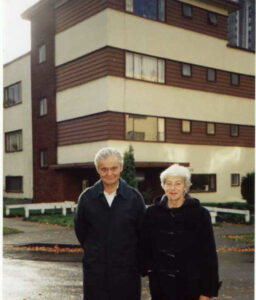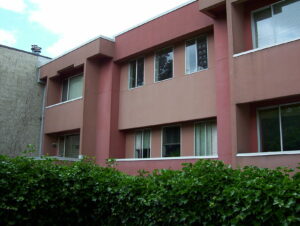Imagine Supportive Housing
While the case of the Kitsilano Citizens’ Committee makes clear that MPA was willing to be engaged in political projects concerned with larger questions of mental health policy, the group was well aware of the urgent need of many members for basic community services and organized support. Their construction of need thus stayed closer to what eventually would become recognized among health professionals and policy makers as the social determinants of (mental) health: income supports and safe and supportive housing, or what is known today as “Housing First.”
Jackie Hooper’s work as an advocate for supportive housing for people with mental health histories – for which she received a Courage to Come Back award in 2014 – began during her years at MPA. Guided by experiential knowledge, Jackie turned her considerable energy and professional capacity to creating supportive housing for people with mental health histories. In the story of Jackie’s apartment projects we see her being mentored and supported by fellow MPA members and also through a growing set of connections with the mainstream mental health practitioners and policy makers. The innovative three-quarter-way housing plan that Jackie conceived and developed during this period, consolidating her identity as a consumer, patient advocate, mental health expert, and policy maker.
Jackie recalled speaking with Lanny in the early 1970s about her idea for using a block of apartments to create a sheltered community for ex-patients. When asked what served as her key example in envisioning the apartment block, Jackie told Geertje Boschma, “…, it was Ward 1 West at UBC. [After all I had been through] it was like heaven – [1 West] became my model. I wanted an apartment block, a housing property.” A mix of peer support, as she had found with MPA, and a quiet space in which to live, combined with communal space and ready access to professional help, as she had experienced at UBC, seemed to constitute the key ingredients in Jackie’s model.

The story of what is now called the Hooper Apartment Block demonstrates the fluid nature of community mental health projects in this era, and the pragmatic flexibility that was characteristic of the early MPA. In 1973 Lanny told Jackie that MPA was focusing their energies on developing a farm project and couldn’t get involved in a sheltered apartment scheme, but he helped Jackie get Local Initiative Program (LIP) funding at MPA to allow Hooper to pursue her goal, and suggested that she check out the recently-passed National Housing Act providing low interest mortgages. Her psychiatrist proposed that Jackie take her idea to Vancouver’s Coast Foundation Society. A non-profit society that had formed in the same year as MPA, originally funded by the BC Teachers Federation, Coast Society volunteers visited formerly hospitalized patients in the boarding homes, providing a drop-in centre and recreational activities in an effort to foster community integration.
The Coast Foundation obtained funding in very similar ways as the MPA, benefiting from new federal grant opportunities, such as LIP, and other local subsidies. Becoming a society in 1972 allowed them, a year later, to obtain funding for housing through the Central Mortgage and Housing Corporation (CMHC) and the Provincial Health Department’s Community Care Services act. Working with Coast research director Peter Tomlinson, Hooper took a leadership role in finding funding and directing the Coast Foundation toward providing housing. This process was not without tension as Hooper explained. Initially, the foundation’s board refused to support the housing project and only after certain board members were replaced with ex-mental patients was organizational endorsement secured. Hooper confided: “Peter and I got the membership [of Coast] on our side, got Barry Coull [from MPA] to organize a momentous meeting … then we got housing.” Hooper’s astute advocacy, and her MPA connections, had been instrumental in moving this project along, including managing the board politics.
Here, we bring together Jackie and Peter Tomlinson memories of Jackie bringing her supported apartment-living ideas to Coast and how the project took shape.
Working with the Coast administration, Jackie began operating the organization’s pioneering supportive housing project, the first of its kind in BC. In a more recent historical account of Coast’s early years, the group is depicted as integral to John Cumming’s Vancouver Plan, providing, “the kind of help that medical, clinical and social models do not. For example, the workers offer personal assistance in finding food, shelter, and sources of income; they help to meet the individuals’ need for friendship by creating social situations through group activities and resocialization projects; and they offer alternative housing facilities.” Still, Jackie’s housing initiative was not a state-driven plan, but rather reflected a grassroots lobby directed by people identifying as advocates, activists and consumers and exerting their expertise, experiential or professional, or both.

Two years later, Jackie successfully sold her apartment idea to MPA and helped purchase what became the Phoenix Apartments. Working with Barry Coull and Stan Persky in the spring of 1975, Jackie helped prepare a comprehensive report describing the acute housing shortage facing the ever-increasing numbers of patients leaving Riverview and set out the rationale for the proposed 36-suite apartment for “ex-patients.” The unique “apartment block concept” which they were proposing, the report contends, would help foster community and basic living skills among people aiming to become independent after long or frequent periods of hospitalization. Writing a year later to William (Bill) Vander Zalm, then provincial minister of Human Resources, Jackie’s correspondence demonstrates how adept she had become in the world of large projects like this, detailing financing, timelines, architectural plans and the category of prospective residents. And she had done her homework too, having previously met and brought on board James Sadler, Vander Zalm’s associate deputy minister and a fellow UBC grad.
An article by Jackie evaluating the Coast Foundation experiment appeared in a 1982 issue of The Social Worker/ La Travailleur Social. This innovative plan to establish a supportive community housing project for people with mental health difficulties that Jackie conceived and helped make a reality at Coast Foundation and MPA in the 1970s is still regarded as a relevant model. This case study demonstrates the importance people on the front lines of early community mental health placed on immediate concerns facing newly-discharged patients, the flexibility of the field in its first years, and the important work done by experiential experts like Jackie.
